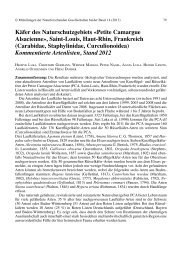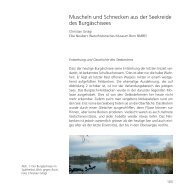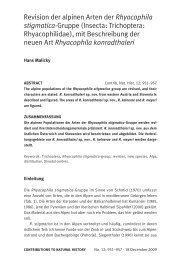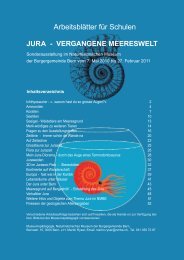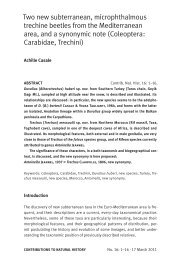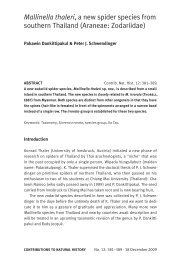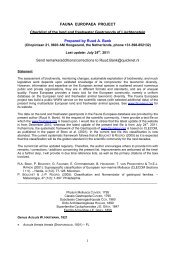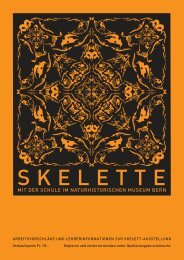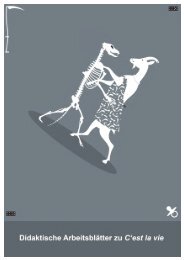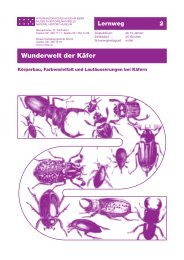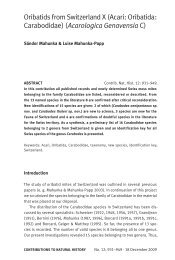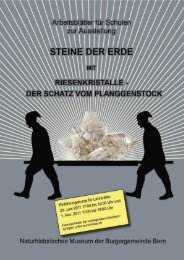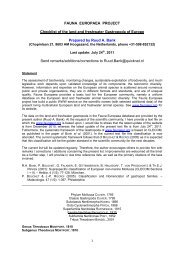PDF-Export ETH-Konsortium: Dokumente - Naturhistorisches ...
PDF-Export ETH-Konsortium: Dokumente - Naturhistorisches ...
PDF-Export ETH-Konsortium: Dokumente - Naturhistorisches ...
You also want an ePaper? Increase the reach of your titles
YUMPU automatically turns print PDFs into web optimized ePapers that Google loves.
Schweizerische mineralogische und<br />
petrographische Mitteilungen<br />
Hofmann, Beda A. / Gnos, Edwin / Eggimann, Manuel<br />
SSMP-Excursion to the Ries and Steinheim meteorite impact craters,<br />
Germany<br />
Schweizerische mineralogische und petrographische Mitteilungen, Vol.85 (2005)<br />
<strong>PDF</strong> erstellt am: 18.06.2010<br />
Nutzungsbedingungen<br />
Mit dem Zugriff auf den vorliegenden Inhalt gelten die Nutzungsbedingungen als akzeptiert. Die<br />
angebotenen <strong>Dokumente</strong> stehen für nicht-kommerzielle Zwecke in Lehre, Forschung und für die<br />
private Nutzung frei zur Verfügung. Einzelne Dateien oder Ausdrucke aus diesem Angebot können<br />
zusammen mit diesen Nutzungsbedingungen und unter deren Einhaltung weitergegeben werden.<br />
Die Speicherung von Teilen des elektronischen Angebots auf anderen Servern ist nur mit vorheriger<br />
schriftlicher Genehmigung des <strong>Konsortium</strong>s der Schweizer Hochschulbibliotheken möglich. Die<br />
Rechte für diese und andere Nutzungsarten der Inhalte liegen beim Herausgeber bzw. beim Verlag.<br />
SEALS<br />
Ein Dienst des <strong>Konsortium</strong>s der Schweizer Hochschulbibliotheken<br />
c/o <strong>ETH</strong>-Bibliothek, Rämistrasse 101, 8092 Zürich, Schweiz<br />
retro@seals.ch<br />
http://retro.seals.ch
Schweizerische Mineralogische und Petrographische Mitteilungen 85, 255-259, 2005<br />
Leaders:<br />
Beda A. Hofmann<br />
Edwin Gnos<br />
Swiss Society of Mineralogy and Petrology SSMP<br />
SSMP-Excursion to the Ries and Steinheim<br />
meteorite impact craters, Germany<br />
Participants:<br />
Jürg Abrecht, Jegenstorf<br />
Cecile Allanic, Neuchätel<br />
Jürg Bühler, Bern<br />
Martin Burkhard, Neuchätel<br />
Ruedi Hänni. Basel<br />
14-16 October 2005<br />
Beda A. Hofmann1, Edwin Gnos2' and Manuel Eggimann'<br />
Introdüction<br />
The Ries and Steinheim twin impact craters (24<br />
and 3.8 km diameter) were formed in the Mio¬<br />
cene. 14.3 ± 0.2 Ma ago (Buchner et al., 2003).<br />
These two craters are the best preserved of the<br />
very few impact craters in central Europe. Chem¬<br />
ical evidence (El Goresy and Chao, 1976) suggests<br />
that the impacting meteoroid had a chondritic<br />
composition, and its size is considered to be<br />
roughly l/2(),h of the crater diameter. This means<br />
that the main meteoroid producing the Ries cra¬<br />
ter had a diameter of ca. 1 km. This meteoroid<br />
possibly had a smaller satellite (Moon"), ca. 100-<br />
200 m in diameter. which produced the Steinheim<br />
impact crater (see for example asteroid 243 Ida<br />
and its small satellite).<br />
Melt fragments (moldavite tektites) and de¬<br />
bris ejecta from the impact site are found as moldavites<br />
(tektites) in Saxony, The Czech Republic<br />
and Austria (e.g.. Lange, 1996; Stöffler et al., 2002)<br />
and as rocky debris in the Graupensandrinne of<br />
southern Germany (e.g.. Buchner etal., 2003), and<br />
even in the Swiss Molasse basin near St. Gallen<br />
(Hofmann. 1973; Krayss, 2004), where Malm lime¬<br />
stone blocks with shatter cones were found. The<br />
aim of the excursion to the Ries was to provide an<br />
overview of the rocks affected by the Ries and<br />
1<br />
Peter Heitzmann, Bern<br />
Birgit Huber. Jegenstorf<br />
Peter Nievergelt, Zürich<br />
Derek Pullan, Leicester GB<br />
Franz Schenker. Meggen<br />
<strong>Naturhistorisches</strong> Museum der Burgergemeinde Bern. Bernastrasse 15. 3005 Bern.<br />
<br />
Steinheim impacts and to study the influence of<br />
impact events on landscape and culture.<br />
Friday, 14. October 2005<br />
(Bern - Winterthur - Nördlingen)<br />
After crossing the fog-covered Swiss Molasse ba¬<br />
sin, the fog made place to the sun and a slightly<br />
hazy late fall landscape. We arrived at the first<br />
outcrop around 13:30 h, starting with lunch.<br />
Outcrops visited<br />
1. Iggenhausen 48° 43.50'N 10° 22.78'E<br />
Small quarry, -0.5 km E of Iggenhausen, geologically<br />
located -9 km outside the impact crater rim.<br />
A small hill of bare limestone consists of a coher¬<br />
ent, but impact-tectonically outward thrust, in¬<br />
tensely shattered Malm limestone sequence<br />
which locally shows karstic pockets filled with<br />
ochre-coloured clay (siderolithic Bolus clay).This<br />
quarry represents the typical, naturally disaggregated<br />
limestone (Gries") used over centuries for<br />
building graded roads. The large limestonc block<br />
can be regarded as a single large clast within the<br />
"Bunte Brekzie" layer (variegated breccia, nearly<br />
- Institut für Geologie. Universität Bern. Baltzerstrasse 2.3012 Bern.<br />
* Present address: Museum d'Histoire naturelle. CH-1211 Geneve 6. <br />
0036-7699/05/0085/255 ©2005 Schweiz. Mineral. Petrogr. Ges.
256 B.A. Hofmann, E. Gnos and M. Eggimunn<br />
unmetamorphosed, dominantly sedimentary im¬<br />
pact ejecta). but the contacts to other lithologies<br />
of the breccia are presently hidden.<br />
2. Seelbronn 48° 44.15'N 10° 28.15'E<br />
Suevite quarry of the Schwenk Zement KG, Ulm<br />
(permission and helmet required). Active suevite<br />
(impact breccia containing a significant compo¬<br />
nent of melt) quarry exploited as cement additive.<br />
The suevite contains abundant vesicular melt<br />
bombs ("Flädle") and shock-metamorphosed<br />
clasts mainly derived from the crystalline base¬<br />
ment. This quarry is presently one of the freshest<br />
-*<br />
X<br />
4V<br />
¦<br />
-w<br />
!*<br />
K<br />
MC<br />
":<br />
**><br />
><br />
m '-..:¦<br />
y-r ¦<br />
X<br />
»7»<br />
4<br />
t&<br />
S.~<br />
3*2*<br />
It» MB<br />
mr. ~-jQr<br />
Fig. 1 Suevite wall in Aumühle quarry displaying wallhardened<br />
trunc-shaped degassing pipes in suevite.<br />
showing both positive and negative shapes. Note the ori¬<br />
entation perpendicular to the surface of the top of the<br />
suevite blankel. Hand in the top right for scale.<br />
-.<br />
outcrop of suevite, where the cowpat-shaped<br />
glassy melt fragments are still preserved. Apart<br />
from the melt fragments, abundant shocked crys¬<br />
talline basement as well as sedimentary cover<br />
fragments are recognizable.<br />
3. Altenbürg (suevite in contact with Malm)<br />
48° 48.83'N 10° 25.87'E<br />
Abandoned suevite quarry declared as bio- and<br />
geotope. The suevite from this quarry was mainl;<br />
used to build the St. Georg church of Nördlinger.<br />
with its tower "Daniel". Because suevite oeecurs<br />
in sharp contact with a coherent sequence of<br />
Malm limestone the Situation was originally inter¬<br />
preted as a volcanic diatreme crosscutting lime¬<br />
stone. Since the recognition of suevite as impactderived<br />
material the limestone block is consid¬<br />
ered allochthonous, too. Near the contact of<br />
suevite to Malm limestone the weathered suevite<br />
shows deposition of caliche veins and -coatings.<br />
4. Nördlingen (St. Georg church)<br />
The tower of the St. Georg church, called "Da¬<br />
niel", is accessible to the public and contains an<br />
apartment oceupied by the guard who lives there<br />
for several days in a row. The tower (and the main<br />
body of the church) constructed 1427-1540 con¬<br />
sist of suevite blocks mainly from the now aban¬<br />
doned Altenbürg quarry. The balcony fence at the<br />
top<br />
of the accessible tower was rebuilt using artifi-<br />
cial "suevite" consisting of basalt and limestone<br />
clasts in a cement-sand matrix. Also the weather<br />
exposed wall parts of the tower outside are par¬<br />
tially replaced with this fake "suevite" which, at<br />
first glance, is easily confused with the true<br />
suevite. Real blocks of suevite allow the study of<br />
this classic impactite in all variations. There is a<br />
stunning view from the tower all around the Ries<br />
crater.<br />
Saturday,<br />
15. October 2005<br />
5. Meyers Keller in Nördlingen<br />
48° 50.48'N 10° 29.6'E<br />
A small rock wall located behind the restaurant<br />
"Meyers Keller" provides one of the best out¬<br />
crops of shocked crystalline basement of the socalled<br />
inner ring of the Ries impact basin. The<br />
main lithologies are gneisses, amphibolites and<br />
minor granites. All rocks are strongly altered to<br />
clay minerals (with textures preserved). Nearby<br />
outcrops of post-impact lacustrine limestones<br />
demonstrate that this outcrop is located very<br />
close to the paleosurface.
Excursion to Ries and Steinheim meteorite impact craters, Germany 257<br />
6. Nördlingen (Rieskratermuseum)<br />
Opening hours 10:00-12:0()h and 14:00-16:00h.<br />
The museum hosts a systematic collection of the<br />
most important meteorite types, an original rock<br />
piece collected during the Apollo Moon missions.<br />
an excellent regional collection describing the dif¬<br />
ferent rock types formed by the Ries impact, and<br />
a lot of well-presented geological information<br />
about the Ries area. Different exhibition parts<br />
explain the dynamic crater-forming process and<br />
give reference to other terrestrial and extraterrestrial<br />
impact craters. A short video gives an impres¬<br />
sion of the landscape of the Ries area before the<br />
impact and shows the sequence of catastrophic<br />
events during the impact and the subsequent geo¬<br />
logic evolution and landscape shaping until the<br />
present.<br />
7. Wengenhausen (carbonates overlaying<br />
crystalline breccia) 48° 54.67'N 10° 27.77'E<br />
Small quarry (classified as geotopej.The outcrop<br />
consists. in its lower part, of shattered crystalline<br />
(probably large crystalline "schölle") and is, in the<br />
upper part, covered by a softer horizon of what is<br />
considered as weathered suevite. The top of the<br />
outcrop is formed by weathering-resistant freshwater<br />
limestone (post-impact Ries lake deposit).<br />
TTie crystalline rocks comprise migmatic biotite<br />
gneisses, granitic dikes, and a lamprophyre dike<br />
in the<br />
(kersantite). Shatter cones were recognized<br />
granitic material, and are locally well recognizable<br />
in the lamprophyre. Whereas the suevite is<br />
strongly weathered, the transition lo the lime¬<br />
stone section is characterized by the decrease in<br />
crystalline clasts. In some parts the limestone<br />
shows bedding, contains abundant 1-2 mm-sized<br />
gastropod shells, cm-sized algal filaments, and
258 B.A. Hofmann, E. Gnos and M. Eggimann<br />
Sunday, 16. October 2005<br />
11. Wallerstein Castle rock (sublacustrine spring<br />
mound) 48° 53.34'N 10° 28.50'E<br />
A former quarry exploiting post-impact sublacus¬<br />
trine spring mound "travertine" deposits is found<br />
in the garden of the Wallerstein Castle of Fürst<br />
Moritz zu Oettingen-Wallerstein. The protected<br />
outcrop is open to the public. A small footpath<br />
leads to the top of the hill opening a splendid view<br />
to the Ries basin (theoretically).The slighly foggy<br />
weather hampered the view to the neighbouring<br />
villages. A detailed description of geochemistry is<br />
given by Pache et al. (2001). Limestone fabrics<br />
produced by different organisms (cyanobacterial<br />
stromatolites, green algae) are well visible on the<br />
limestone walls.<br />
12. Untcrwilflingen<br />
48° 54.89'N 10° 26.77'E<br />
The eastern parts of this quarry consist of impactshocked<br />
and transported crystalline basement<br />
comprising garnet-biotite-gneisses, cordieritebearing<br />
gneisses. amphibolites and granitoid<br />
rocks. Locally thin (centimetric) suevite veins are<br />
visible. In the central part of the quarry this crys¬<br />
talline material is covered with a backfall suevite<br />
containing large shattered crystalline blocks and<br />
abundant, flow-oriented glass bombs ("Flädle").<br />
In contrast to the black color of fresh glass in<br />
other outcrops, it is altered to whitish soft materi¬<br />
al here, pointing to a complete replacement of the<br />
tn<br />
4-r<br />
C3<br />
o<br />
5pc ffl s.<br />
glass by secondary minerals (probably clays and<br />
other sheet Silicates, and zeolites). Bunte Brekzie<br />
prevails at the west side of the quarry. containing<br />
well-recognizable fragments of white, coarsegrained<br />
Triassic Stubensandstein, and red Keuper<br />
marl. An obviously strongly shocked white, friable<br />
aplitic clast (approx. 15x10x10 cm) from the<br />
suevite was investigated to check for the presence<br />
of high-pressure minerals. The X-ray diffraction<br />
pattern of the fraction
Excursion to Ries and Steinheim meteorite impact craters, Gerrnany 259<br />
influence of meteoric water and C02, reacted<br />
back to form CaCO: cementing the porous lime¬<br />
stone breccia.<br />
14. Pharion'sche Sandgrube near Steinheini<br />
(fossiliferous sands) 48° 41.1'N 10° 3.63'E<br />
The classic locality (quarry) yielded abundant<br />
mammal, reptile, insect and plant fossils, and is<br />
now protected and fenced. A small area located<br />
above the main is quarry<br />
hunters.The deposits are<br />
presently open for fossil<br />
dated at 13-14 Ma, thus<br />
formed in a crater lake just after the crater forma¬<br />
tion by meteorite impact at 14.3 Ma.The associa¬<br />
tion of fossils points to warmer climatic condi¬<br />
tions with annual average temperature of ca. 15°C.<br />
All participants had the possibility to collect fossil<br />
fresh water gastropods of the Gyraulus species<br />
(planorbis). See Tütken et al. (2006) for recent<br />
work on Steinheim and the use of isotopes to re¬<br />
construct a former ecosystem.<br />
15. Short visit to the Meteor Crater Museum<br />
in Steinheim, with good samples of shatter cones.<br />
be collected at Steinheim<br />
which cannot presently<br />
due to a lack of exposures.<br />
Back to Bern with stop<br />
time 20:00.<br />
References<br />
in Winterthur. Arrival<br />
Buchner. E.. Seyfried. H. and van den Bogaard. P (2003):<br />
-"'Ar/^Ar laser probe age determination confirms<br />
Ries impact crater as the source of glass particles in<br />
Graupensand sediments (Grimmelfingen Forma¬<br />
tion. North Alpine Foreland Basin). Int. J. Earth Sei.<br />
92. 1-6.<br />
El Goresy, A. and Chao, E.C.T. (1976): Evidence of the<br />
impacting body of the Ries crater. The discovery of<br />
Fe/Cr/Ni veinlets below the crater bottom. Earth<br />
Planet. Sei. Lett. 31. 330-340.<br />
Hofmann. F. (1973): Horizonte fremdartiger Auswürf¬<br />
linge in der ostschweizerischen Oberen Süsswassermolasse<br />
und Versuch einer Deutung ihrer Entste¬<br />
hung als Impaktphänomen. Eclogae Geol. Heb: 66.<br />
83-100.<br />
Hough. R.M.. Gilmour. I.. Pillinger. CT. Arden. J.W..<br />
Gilkes. K.W.R.. Yuan. J. and Milledge. H.J. (1995):<br />
Diamond and Silicon carbide in impact melt rock<br />
from the Ries impact crater. Nature 378.4144.<br />
Krayss. E. (2004): Raum Wittenbach-Häggenschwil-<br />
Bernhardzell. Berichte St. Galler Naturwiss. Ges. 90.<br />
35-56.<br />
Lange. J.M. (1996): Tektite glasses from Lusatia<br />
(Lausitz). Germany. Chemie der Erde 56.498-510.<br />
Pache. M.. Reitner. J. and Arp. G. (2001): Geochemical<br />
evidence for the formation of a large Miocene Tra-<br />
vertine" mound at a sublacustrine spring<br />
Arp, G. (1995): Lacustrine bioherms,spring mounds, and<br />
marginal carbonates of the Ries-impact-crater (Mio¬<br />
cene, Southern Germany). Facies 33. 35-90. Received 26 February 2006<br />
in a soda<br />
lake (Wallerstein Castle rock.Nördlinger Ries, Ger¬<br />
many). Facies 45.211-230.<br />
Stöffler. D.. Artemieva. N.A. and Pierazzo. E. (2002):<br />
Modeling the Ries-Steinheim impact event and the<br />
formation of the moldavite strewn field. Meteorilics<br />
and Planetary Science 37. 1893-1907.<br />
Tütken. T. Vennemann. TW.. Janz, H. and Heizmann,<br />
E.RJ (2006): Palaeoenvironment and palaeoclimate<br />
of the Middle Miocene lake in the Steinheim basin,<br />
SW Germany: A reconstruction from C, O. and Sr<br />
isotopes of fossil remains. Palaeogeography. Palaeoclimatology,<br />
Palaeoecology 241,457-491.



